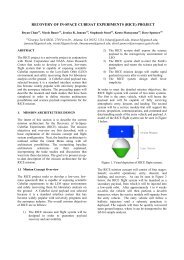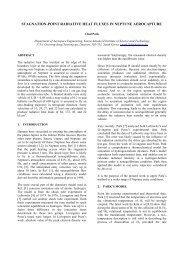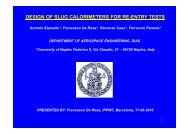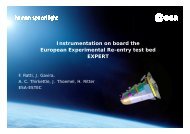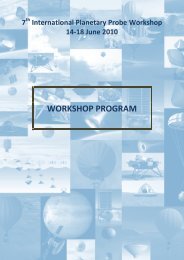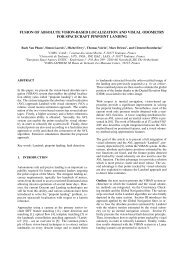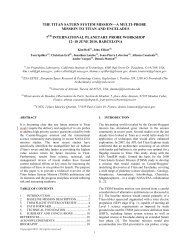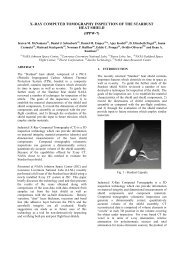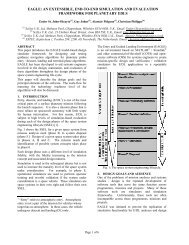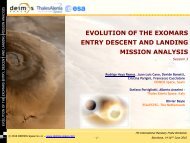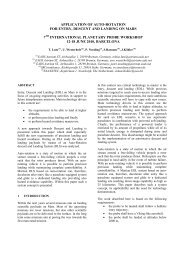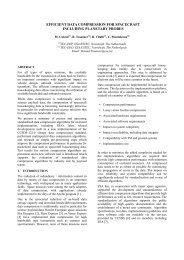IPPW-7 Arrival Guide - International Planetary Probe Workshop
IPPW-7 Arrival Guide - International Planetary Probe Workshop
IPPW-7 Arrival Guide - International Planetary Probe Workshop
Create successful ePaper yourself
Turn your PDF publications into a flip-book with our unique Google optimized e-Paper software.
7 th <strong>International</strong> <strong>Planetary</strong> <strong>Probe</strong> <strong>Workshop</strong><br />
14-18 June 2010<br />
<strong>Planetary</strong> Protection Short Course<br />
12-13 June 2010<br />
<strong>IPPW</strong>-7 ARRIVAL GUIDE
Welcome to <strong>IPPW</strong>-7!<br />
This guide has been compiled to help visitors to <strong>IPPW</strong>-7 and to Barcelona get the most<br />
out of their time here. It should also answer some basic questions, make it easy to<br />
arrive, and provide information on things to do when not attending workshop<br />
sessions. Some important details (emergency numbers, expected weather, etc.) are<br />
also included. This file is intended to be read before or during your journey to<br />
Barcelona. But, it might be a useful reference once on-site also.<br />
Important details about travel or costs should be checked with a suitable authority.<br />
Use this document at your own risk!<br />
CONTENTS<br />
ARRIVAL............................................................................................................................................................. 2<br />
PUBLIC TRANSPORT ........................................................................................................................................... 3<br />
WEATHER .......................................................................................................................................................... 6<br />
CURRENCY & CASH ............................................................................................................................................ 6<br />
LANGUAGES ...................................................................................................................................................... 6<br />
ELECTRICITY....................................................................................................................................................... 6<br />
TELEPHONE ....................................................................................................................................................... 6<br />
LOCAL TIME ....................................................................................................................................................... 7<br />
EMERGENCY PHONE NUMBERS ......................................................................................................................... 7<br />
SAFETY AND SECURITY....................................................................................................................................... 7<br />
HOW TO REACH HOTEL ALIMARA (<strong>IPPW</strong> VENUE) ............................................................................................... 8<br />
HOW TO REACH COSMOCAIXA (SHORT COURSE VENUE) ................................................................................... 9<br />
MAPS............................................................................................................................................................... 10<br />
TOURISM IN THE CITY ...................................................................................................................................... 11<br />
ABOUT BARCELONA......................................................................................................................................... 13<br />
OUTSIDE THE CITY............................................................................................................................................ 13<br />
- 1 -
ARRIVAL<br />
Barcelona is served by Barcelona <strong>International</strong> Airport (BCN) near the town of El Prat de Llobregat, about 12km<br />
(straight-line) from the centre of Barcelona. The airport is connected to the city by a train, scheduled bus<br />
transfers, a dedicated airport bus service (Aerobus), and taxis. There are 2 terminals — most flights arrive at T1,<br />
with the exception of EasyJet flights and some other low cost airlines that use T2. There are inter-terminal<br />
transfer buses, but it is worth making sure which terminal you need.<br />
We recommend you to take the Aerobus from your terminal until the final stop, Plaça Catalunya, where you<br />
will then easily be able to connect to other transport to reach your final destination.<br />
Airport Website:<br />
Aerobus:<br />
http://tinyurl.com/<strong>IPPW</strong>7airport<br />
http://www.aerobusbcn.com/<br />
Aerobus<br />
Single ticket: €5<br />
Approximate duration: 30 minutes<br />
From the airport to the city centre (Plaça Catalunya):<br />
Bus A1: Buses from T1 Everyday from 06:10 to 01:05, every 10 minutes<br />
(between 07:30 to 22:25 frequency increases to every 5 minutes)<br />
Bus A2: Buses from T2 Everyday from 06:00 to 01:00, every 20 minutes<br />
(between 07:00 to 23:00 frequency increases to every 10 minutes)<br />
From the city centre to the airport:<br />
Bus A1: Buses to T1 Everyday from 05:30 to 00:30, every 10 minutes<br />
(between 06:50 to 21:45 frequency increases to every 5 minutes)<br />
Bus A2: Buses to T2 Everyday from 06:00 to 01:00, every 20 minutes<br />
(between 06:50 to 22:20 frequency increases to every 10 minutes)<br />
Taxi<br />
A taxi from the airport to the city centre will cost around €30, and may be worth it if you are travelling with<br />
more than three people. They are black and yellow, and found by following signs at either terminal.<br />
Train<br />
For those on a tight budget and happy to spend a little more time and effort, the very cheapest way into the<br />
city is by train from T2 (use the free inter-terminal bus to get to the station from T1). Once at the station buy a<br />
T-10 transport card (see below for more details) and you will get to Passeig de Gracia (city centre) for €0.78 in<br />
18 minutes (trains leave the airport at 08 and 38 minutes past each hour from 06.08 to 22.38) with onward<br />
connections via metro to CosmoCaixa or Hotel Almera all on the same ticket!<br />
- 2 -
PUBLIC TRANSPORT<br />
In Barcelona city there is an Integrated Tariff System and the cheapest way to travel by public transport (either<br />
bus or underground) is to use a travel card. The transport system is very comprehensive, and can be a bit<br />
overwhelming – however, it is worth getting to grips with it as it is cheap, efficient and will get you seeing more<br />
of the city. Whichever ticket you buy, you will need to put it through the machines, to get onto the platform of<br />
the metro or trains, or after boarding the buses or trams. The tickets cover the local RENFE services (Spanish<br />
railway), the Catalan FGC commuter trains, the Metro, the trams and the buses.<br />
METRO<br />
There are 6 metro lines in Barcelona, each identified by a number and a colour.<br />
Platform signs and decoration distinguish between lines and avoid confusion at<br />
interchanges. Direction is indicated by the final station on each line. Metro stations<br />
are easy to find at street level – a large red ‘M’ on a white diamond background.<br />
For <strong>IPPW</strong>, the most important line is LINE 3 – GREEN. The conference venue, Hotel<br />
Alimara, is adjacent to the MUNDET station on Line 3. See the sketch on the next<br />
page.<br />
Public Transport Website: http://www.tmb.cat<br />
Where to Buy Tickets<br />
<br />
<br />
<br />
Any train, FGC, metro or tram station<br />
Metro ticket offices<br />
TMB Customer Service Centres<br />
T-10 (Zone 1 - €7,80)<br />
(Recommended)<br />
The travel card “T-10” allows 10 journeys on any<br />
means of transport (trains, buses, trams). A single<br />
ticket can be used for any combination between 1<br />
person making 10 journeys and 10 people travelling<br />
together on 1 journey (provided it is validated 10<br />
times). You may change mode of transport (e.g.<br />
switch from bus to metro, etc.) to complete a<br />
journey within a period of 75 minutes.<br />
Individual Tickets (€1,35)<br />
Single journey tickets are also available, and the only<br />
kind available directly from bus drivers.<br />
T-Dia (Zone 1 - €5,90)<br />
Unlimited journeys in the zone defined by the first<br />
use of the card, starting from time of first use until<br />
the end of service on that day (i.e. not a movingwindow<br />
24hour pass). Each passenger requires their<br />
own ticket (unlike a T-10).<br />
Barcelona Tourist Travel Cards<br />
Tourist travel cards are valid for an unlimited<br />
number of journeys in a fixed number of<br />
consecutive days. 2 days: €11,20; 3 days: €15,90;<br />
4 days: €20,40; 5 days: €24,10. Each passenger<br />
requires their own ticket (unlike a T-10).<br />
- 3 -
METRO LINE 3<br />
- 4 -
METRO, TRAM, FGC NETWORKS<br />
- 5 -
WEATHER<br />
The weather in Barcelona is typically Mediterranean. Summers are hot, winters mild, and most rainfall is in<br />
spring and autumn. It is unlikely to rain during the week of <strong>IPPW</strong> (June rainfall averages 40mm in the month).<br />
The average June temperature is 24˚C (75˚F) during the day and 16˚C (61˚F) at night. Even if it doesn’t feel too<br />
warm, the sun will be strong. The Mediterranean Sea is available nearby to cool off in …<br />
CURRENCY & CASH<br />
Catalunya, within Spain’s borders, is inside the Euro zone. You may enter Spain with an unlimited amount of<br />
currency. Exporting more than €6000 requires a customs declaration. Changing currency is straightforward at<br />
the usual exchange services at the airport. Travellers Cheques are not in common use, but can be exchanged at<br />
banks, bureaux de change (Catalan: Canvi, Spanish: Cambio), and some hotels. Banks offer the best rates. Rates<br />
in cash dispensers are also reasonable. The usual machine limit is €300 per day.<br />
Note that payment by credit or debit card usually requires showing a photographic ID together with your card.<br />
A drivers license or passport suffices for overseas visitors. Servei Caixa machines not only dispense cash, but<br />
also will provide you with theatre or concert tickets, and credit for mobile phones.<br />
Note that the local notation for the decimal point is a comma , rather than period. Further, the period can<br />
delimit each third power of ten – the convention is directly the opposite of that in many other countries. This<br />
applies for all quantities, so foreigners sometimes need to think about the meaning of numbers presented as<br />
1.235,14 (one thousand two hundred and thirty five point one four).<br />
LANGUAGES<br />
Barcelona has two local languages: Catalan and Castellano (Spanish). Most signs are in both, and most menus<br />
in tourist areas are also in English and French, and sometimes German. English is broadly spoken and<br />
understood, especially by younger people. Catalan is a pure romance language, akin to Langue d’Oc or<br />
Provençal, spoken by around 10 million locals, and another 10 million people elsewhere. It is NOT a dialect but<br />
a full language with a pure Latin grammar. Catalans are very proud of their independent culture.<br />
ELECTRICITY<br />
Electrical current is 220V or 225V, 50Hz. European-style two-pin plugs are standard.<br />
TELEPHONE<br />
The international dialling code for Spain is 34. The Barcelona area code for fixed line telephones is 93, and cell<br />
phone numbers start with a 6. Internet cafes or “locutorios” are scattered throughout the city, and the city has<br />
a growing public WIFI system (http://www.bcn.cat/barcelonawifi/en) as well as free WIFI in increasing numbers<br />
of cafes and bars.<br />
- 6 -
LOCAL TIME<br />
The local time in summer is GMT+2h. Much more importantly, Barcelona operates on Spanish Time. Days are<br />
long in Barcelona. Morning (el matí) lasts until 1 or 2pm. Lunch is typically between 2pm and 4pm (migdia). The<br />
afternoon (la tarde) starts at 4pm, and lasts until dinner, between 9pm and 11pm. You will find tourist<br />
restaurants that offer more standard eating times, but if you want the authentic experience, most restaurants<br />
are empty until 10pm at the weekends. These hours also inform shop opening times – big shops in the city<br />
centre open from 10am until 8.30pm or even 10pm in the case of Corte Ingles – however, most smaller shops<br />
are shut from 2pm until between 4.30-5.50pm, but then stay open until 8.30pm. Some museums also shut for<br />
a couple of hours in the middle of the day, and then open until 7 or 8pm – so the best thing for some afternoon<br />
free time is to take a siesta or go to the beach or the park.<br />
EMERGENCY PHONE NUMBERS<br />
Please do avoid any form of emergency. In case it becomes necessary to get assistance with any kind of<br />
emergency, unfortunately there are several different numbers, in the following table. If in doubt, start with the<br />
European Emergency Number – 112.<br />
General Emergencies 112<br />
Medical Emergencies 061<br />
Guàrdia Urbana (Local Police) 092<br />
National Police 091<br />
Mossos d'Esquadra (Catalan Police) 088<br />
Guardia Civil Police Force 062<br />
SAFETY AND SECURITY<br />
Barcelona is a relatively safe city with low crime rates. The main nuisance is petty theft by pickpockets in the<br />
dense tourist areas. There are teams of very adept thieves who are expert at exploiting tourists’ bewilderment.<br />
Visitors arriving are often tired in unfamiliar surroundings, struggling with baggage and language and heat -<br />
with larger than average quantities of cash from a recent exchange - and they form easy targets.<br />
PLEASE PAY ATTENTION TO YOUR POCKETS AND BAGS!<br />
<br />
<br />
Do not keep wallets or money in back pockets.<br />
Wear backpacks and other bags on your FRONT when riding on escalators or in elevators, or walking<br />
through crowded streets.<br />
- 7 -
HOW TO REACH HOTEL ALIMARA (<strong>IPPW</strong> VENUE)<br />
Address: Calle Bereguette 126<br />
Barcelona<br />
Tel. +34 93 427 00 00<br />
WGS84:<br />
Web:<br />
N41°26’02.53” E002°08’51.00”<br />
http://tinyurl.com/ippwAlimara<br />
From City Centre<br />
Take the metro line 3 (green) direction Trinitat Nova to Mundet. Use exit signed “Can Marcet”, and you will<br />
find the hotel one block to the south (left) on Carrer de Bereguette (see map on next page).<br />
From Airport<br />
Metro Line 3 goes from Passeig de Gracia and Plaça Catalunya, so to get from the airport, take either the<br />
Aerobus to Plaça Catalunya or the train to Passeig de Gracia and change onto the metro – you will need to buy<br />
a separate ticket (see above) if you have travelled on the Aerobus.<br />
From CosmoCaixa<br />
Bus 60 goes directly between CosmoCaixa and Hotel Alimara, every 10-15 minutes and takes about 25 minutes,<br />
and yes – you can use your T-10 ticket. The link below takes you to a timetable and plan of the route. The stop<br />
for CosmoCaixa is called UOC when arriving from Alimara, and ComsoCaixa when leaving. The stop for the hotel<br />
is called Mundet. Many buses have an electronic display that indicates the next stop — or ask the driver for<br />
help.<br />
NOTE<br />
1. Bus 60 Information: http://tinyurl.com/ippwBus60<br />
2. Maps available on page 10.<br />
3. A Google Earth file (.kmz) is available for download from the <strong>IPPW</strong> website with all important <strong>IPPW</strong><br />
locations indicated. See: http://planetaryprobe.eu/download.php (under “Location Information”)<br />
- 8 -
HOW TO REACH COSMOCAIXA (SHORT COURSE VENUE)<br />
Address: Carrer Isaac Newton 26<br />
Ronda de Dalt<br />
Barcelona<br />
Tel. +34 93 253 74 67<br />
WGS84:<br />
Web:<br />
N41°24’46.38” E002°07’53.35”<br />
http://tinyurl.com/ippwCosmo<br />
From City Centre - FGC<br />
1. Take the Ferrocarrils de La Generalitat (FGC- L7) from Plaça Catalunya (aerobus) or Passeig de Gracia<br />
(train from airport) to Av. Tibidabo<br />
Number of stops: 6<br />
Waiting time: 2 mins<br />
Journey time: 8 mins<br />
2. Then, one of the following options:<br />
Walk from Av. Tibidabo station (10 minutes, including a steep uphill section)<br />
Take the historic Tramvia Blau up the steep section, then walk (€2,50, 10 minutes, departure each<br />
30 minutes)<br />
Take bus 196 from Av. Tibidabo/Plaça Kennedy (5 minutes, using the same ticket as the train), to<br />
the CosmoCaixa stop (opposite entrance).<br />
From City Centre - Taxi<br />
A taxi from the city centre to CosmoCaixa should cost around €12. Maximum taxi capacity is 4 passengers.<br />
From Hotel Alimara<br />
Bus 60 goes directly between CosmoCaixa and Hotel Alimara, every 10-15 minutes and takes about 25 minutes,<br />
and yes – you can use your T-10 ticket. The link below takes you to a timetable and plan of the route. The stop<br />
for CosmoCaixa is called UOC when arriving from Alimara, and ComsoCaixa when leaving. The stop for the hotel<br />
is called Mundet. Many buses have an electronic display that indicates the next stop — or ask the driver for<br />
help.<br />
NOTE<br />
1. Bus 60 Information: http://tinyurl.com/ippwBus60<br />
2. Maps available on page 10.<br />
3. A Google Earth file (.kmz) is available for download from the <strong>IPPW</strong> website with all important <strong>IPPW</strong><br />
locations indicated. See: http://planetaryprobe.eu/download.php (under “Location Information”)<br />
- 9 -
MAPS<br />
CosmoCaixa and how to reach it<br />
Green line showing<br />
bus 60 from Hotel<br />
Alimara<br />
Cosmocaxia<br />
(short course<br />
venue)<br />
Hotel Alimara and how to reach it<br />
FGC station exit, with<br />
red line showing<br />
walking route to<br />
Cosmocaxia, blue line<br />
showing Tramvia Blau<br />
route, and pink line<br />
showing bus 196<br />
Exit from metro line 3 Mundet<br />
station with red line showing<br />
route to Hotel Alimara and<br />
green line showing bus route to<br />
CosmoCaixa<br />
Hotel<br />
Alimara<br />
To CosmoCaixa<br />
- 10 -
TOURISM IN THE CITY<br />
Barcelona houses a great number of museums, which cover different areas and eras.<br />
The National Museum of Art of Catalonia (MNAC) offers a well-known collection of<br />
Romanesque art while the Barcelona Museum of Contemporary Art (MACBA) focuses<br />
on post-1945 Catalan and Spanish art. The Fundació Joan Miró, Picasso Museum and<br />
Fundació Antoni Tàpies hold important collections of these world- renowned artists.<br />
Several museums cover the fields of history and archeology, like the City History<br />
Museum, the Museum of the History of Catalonia, the Archaeology Museum of<br />
Catalonia, the Barcelona Maritime Museum and the privately-owned Egyptian<br />
Museum. CosmoCaixa is a science museum that received the European Museum of<br />
the Year Award in 2006, and is the host venue of the <strong>Planetary</strong> Protection Short<br />
Course at <strong>IPPW</strong>.<br />
The Rambla, the Ribera, Plaça de Catalunya, Passeig de Gràcia, Diagonal and the<br />
numerous shopping centres scattered round the city and its suburban areas attract a<br />
large part of the shoppers. But throughout the city one finds many lesser known<br />
shopping streets and neighbourhood shops, besides the city markets and street fairs.<br />
A nice introduction to the city can be had by taking the Tourist Bus, follow the links<br />
on the Barcelona Tourist Office page below.<br />
The Barri Gótic (Gothic Quarter) is the heart of the city. A walk through its ancient<br />
streets is essential to get an idea of the layers of Barcelona's history: from the Roman<br />
walls to the Picasso museum through the well-preserved Gothic buildings. You shall<br />
visit the Cathedral, whose origins go back to the 13th century and is notable for its<br />
medieval choir stalls, fine Gothic chapels and shady cloister.<br />
Barcelona faces the sea. The 1992 Olympic Games gave the city the opportunity to<br />
redesign its seafront, which now stretches along four kilometres of beaches. To the<br />
south, Montjuïc Park is the site of the Olympic Village and provides unbeatable views<br />
of the seafront. The new World Trade Centre is located in the harbour. La Rambla<br />
extends, via a walkway, over the sea to the Mare Magnum, a leisure complex which<br />
houses the Aquarium (the biggest aquarium in Europe, very family oriented), and is<br />
close to the refurbished Barceloneta beaches.<br />
- 11 -
Some of the best websites for further information are listed below:<br />
Barcelona Tourist office pages<br />
The city council tourism pages (English version - but<br />
there is more information if you are able to read<br />
Castellan or Catalan. Also links through to museums.<br />
Spotted by Locals: we like this site for suggestions of<br />
restaurants, cafes etc.<br />
This is a useful site if you are travelling with kids, with<br />
suggestions for entertainment<br />
http://tinyurl.com/ippwTourism<br />
http://tinyurl.com/ippwBcnCity<br />
http://www.spottedbylocals.com/barcelona<br />
http://www.kidsinbarcelona.com<br />
Our first suggestions for family visits include:<br />
<br />
<br />
<br />
<br />
<br />
<br />
Aquarium (http://tinyurl.com/ippwAquarium)<br />
Tibidabo – amusement park for all ages and great view of the city<br />
Montjuïc – museums, castle, parks, the Magic Fountain and the Spanish Village<br />
Cable cars – across the harbour and up Montjuïc<br />
Ciutadella Park and Zoo<br />
Beaches!<br />
- 12 -
ABOUT BARCELONA<br />
Barcelona was founded on the Mediterranean coast, between two rivers, over 2,000 years ago. It is located in<br />
the north-east of the Iberian Peninsula, just a short distance from France. Since then, it has been the traditional<br />
gateway to Spain. Through it entered Romans, Arabs and Christians, as well as the many diverse cultures, which<br />
came to enrich its heritage. The traces of this history and diversity can be followed as you walk through the<br />
city; through its Gothic Quarter, built on the Roman ruins; through its art-nouveau Eixample district, presided<br />
over by Gaudí’s exuberant architecture, which at the same time reveals an ordered and rational urban layout.<br />
This diversity and harmony are also apparent in the character of the people of Barcelona, who are enterprising<br />
and hard-working, enjoy life and, in particular, have great civic pride and are lovers of culture.<br />
In just over two decades, Barcelona has completely transformed its range of facilities and attractions. It has<br />
done so by displaying a dynamic character and pioneering spirit, which are perfectly visible in its new urban<br />
and architectural layout. The city continues to enjoy spring-like climatic conditions, and offers the visitor its<br />
own unique lifestyle, which is particularly evocative and appealing. It combines the best of the tranquil<br />
Mediterranean coast with the thrust and capacity for innovation of a young society.<br />
OUTSIDE THE CITY<br />
Beaches<br />
The city beaches stretch north from Barcelonetta and the Port Olimpic – they are great for a short visit, or to<br />
combine with bars and restaurants. The beaches to the south of the city at Platja de Castelldefels (a 20 minute<br />
train ride south from Plaça Catalunya station, with 2 trains an hour) are much cleaner and worth the effort if<br />
you want to spend more than a couple of hours (they also have cafes and bars despite being out of the city).<br />
For a beach day trip, we would suggest Sitges, further south. It is the preferred destination for locals, with a<br />
proper town, several beaches, some museums and many restaurants and bars. There are 4 trains an hour from<br />
Estacio Sants or Passeig de Gracia stations, and the trip takes about 45 mins (you would need a 3 zone ticket<br />
rather than the 1 zone ticket that you would need in the city).<br />
Montserrat<br />
The jagged mountain of Montserrat holds a special significance for Catalans, and is well worth a day trip, which<br />
can easily be done without a car. There is a monastery with the famous Black Madonna, associated museums<br />
of monastery life and a great art collection, and wonderful walking in a truly spectacular natural park. It is<br />
possible to book on a trip on a coach with a guide from the tourist information centre underneath Plaça<br />
Catalunya. However, it is also very easily reached by public transport, taking a train from Plaça Espanya station<br />
and then either a cable car or rack-and-pinion railway to the monastery. From this level, funicular trains can<br />
take you to the summit, or you can hike up the well-marked trails.<br />
There are various combination tickets which save money, but you have to know how you want to travel (e.g.<br />
the cable car doesn’t operate in high winds). There is more information at the links below, and there is also a<br />
helpful desk in Plaça Espanya station dedicated to Montserrat visitor information and ticket sales. Plaça<br />
Espanya is a huge underground station, but as long as you follow signs for line R5 you will find the correct part<br />
of the station whichever entrance you use.<br />
- 13 -
Rack and Pin railway and funiculars<br />
Cable Car<br />
Monastery<br />
http://tinyurl.com/ippwMontserrat<br />
http://tinyurl.com/ippwMontserrat2<br />
http://www.abadiamontserrat.net/angles<br />
Figueres<br />
About 2 hours on the train from Barcelona is the town of Figueres, where you will find the Theatre-Museum<br />
Dali, one of the most incredible day trips for an insight into the creative mindscape of Salvador Dali. There is<br />
not much else to say about the town itself, but it is s starting point to reach some of the more isolated and<br />
scenic parts of the coastline of Catalunya and the beautiful old port village of Cadaqués.<br />
Figueres Dali Museum: http://tinyurl.com/ippwDali<br />
Cadaqués:<br />
http://www.cbrava.com/cadaques_uk.htm<br />
Northern Catalunya Coastline<br />
Cadaqués<br />
- 14 -



